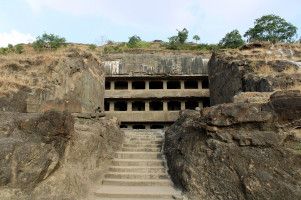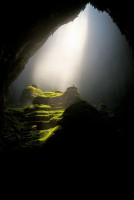Pandava Caves
Duration
1 to 2 Days
1 to 2 Days
Best time to visit
Oct-Feb
Oct-Feb
Theme
Heritage
Heritage
Pandava Caves Travel Guide
Pandava Caves, located in Maharashtra, India, are a group of ancient rock-cut caves that hold significant historical and cultural importance. These caves are believed to have been carved out in the 1st century BC and are associated with the Pandavas from the Indian epic Mahabharata. The intricate carvings, sculptures, and architecture of the caves showcase the rich artistic heritage of India. The caves are famous for their religious significance and historical relevance, making them a popular destination for history buffs and spiritual seekers.Top Attractions in Pandava Caves
- Explore the intricate rock-cut caves
- Admire the ancient sculptures and carvings
- Visit the Chaitya Hall and Vihara at the site
- Enjoy the panoramic views of the surrounding landscape
Pandava Caves is Famous for
Its historical and religious significance.Top Attractions in Pandava Caves
- Exploring the ancient rock-cut caves
- Admiring the intricate sculptures and carvings
- Visiting the Chaitya Hall and Vihara
What's Great about Travelling to Pandava Caves?
- Experience rich historical and cultural heritage
- Perfect for history and spirituality enthusiasts
- Scenic views and peaceful surroundings
What's Not So Great about Travelling Pandava Caves?
- Limited accommodation options
- Remote location may require careful planning
- Not ideal for those seeking modern amenities
Travel Tips for Pandava Caves
- Check for any entry fees or permits required
- Wear comfortable shoes for exploring the caves
- Respect the religious significance of the site
Important Pandava Caves trip information
- Ideal Duration: 1-2 days
- Best Time to Visit: October to March
- Nearby Airports and Railway Stations: Aurangabad Airport and Aurangabad Railway Station
Per Person
10,000
*EXCLUDING APPLICABLE TAXES 4.9 Ratings
( 200 Reviews )
( 200 Reviews )
Per Person
6,500
*EXCLUDING APPLICABLE TAXES 4.9 Ratings
( 200 Reviews )
( 200 Reviews )
FAQ's on Pandava Caves
Q1: What is the best time to visit Pandava Caves?
The best time to visit Pandava Caves is during the winter months from November to February when the weather is pleasant and ideal for exploring the caves. Additionally, this period coincides with various local festivals and events, adding to the cultural experience. It is advisable to avoid the monsoon season from June to September due to heavy rainfall that may hinder outdoor activities.
Q2: Do I need a visa to travel to Pandava Caves?
Most tourists visiting Pandava Caves will need a tourist visa to enter the country. However, some nationalities may be eligible for visa-on-arrival or visa-free entry for a limited period. It is recommended to check with the local embassy or consulate for specific visa requirements based on your nationality before planning your trip.
Q3: What are the must-visit attractions in Pandava Caves?
The must-visit attractions in Pandava Caves include the ancient rock-cut caves that date back to the 1st century BC, showcasing intricate carvings and historical significance. Visitors should also explore the surrounding natural beauty, such as the lush greenery and scenic viewpoints offering panoramic views of the landscape. Additionally, nearby attractions like historic temples and local markets provide a glimpse into the rich cultural heritage of the region.
Q4: Is Pandava Caves a safe place to travel?
Pandava Caves is generally considered a safe destination for travelers. However, like any other tourist spot, it is advisable to take standard precautions such as safeguarding belongings and being aware of your surroundings. It is recommended to avoid isolated areas, especially after dark, and follow local guidelines for a safe and enjoyable travel experience.
Q5: What is the local currency in Pandava Caves and can I use credit cards?
The local currency in Pandava Caves is the Rupee. While credit cards are accepted at some hotels, restaurants, and larger establishments, it is advisable to carry cash for smaller vendors and local markets. ATMs are also available in major towns for convenient access to money. Inform your bank about your travel plans to ensure seamless card transactions during your visit.
Q6: What is the local cuisine like in Pandava Caves?
The local cuisine in Pandava Caves offers a diverse range of flavors and dishes, influenced by regional ingredients and traditional cooking methods. Visitors can savor authentic dishes such as spicy curries, flavorful rice preparations, and delectable sweets. Vegetarian options are widely available, reflecting the local dietary preferences. Travelers with specific dietary requirements can easily find options tailored to their needs, ensuring a gastronomic exploration of the region's culinary delights.
Q7: What transportation options are available in Pandava Caves?
Transportation options in Pandava Caves include public buses, taxis, and auto-rickshaws for convenient travel within the region. Visitors can also opt for car rentals or hire a driver for a more personalized and flexible touring experience. Local guides are available for guided tours of the caves and nearby attractions, providing valuable insights into the history and culture of the area. It is recommended to plan transportation in advance to optimize your travel itinerary and make the most of your visit.
Q8: Are there any cultural norms or etiquette I should be aware of when visiting Pandava Caves?
When visiting Pandava Caves, it is important to respect local customs and traditions. Dress modestly when visiting religious sites and show reverence in sacred places. Greeting locals with a polite "Namaste" and being courteous in interactions fosters a positive cultural exchange. Avoid public displays of affection and follow any specific guidelines at heritage sites to preserve the historical significance. Taking off your shoes before entering certain buildings is a common practice, so being mindful of these cultural norms enhances your experience and shows respect for the local customs.
Q9: I am a travel agent. How can I buy travel leads of Pandava Caves?
Register yourself as a travel agent at agents.tripclap.com and then you can buy travel leads to Pandava Caves once your account is approved. For more details contact our support team at +91-8069186564 or support@tripclap.com


